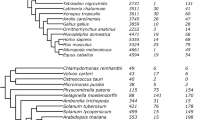Abstract
The deduced amino acid sequences from 1200 Haemophilus influenzae genes was compared to a data set that contained the orfs from yeast, two different Archaea and the Gram+ and Gram− bacteria, Bacillus subtilis and Escherichia coli. The results of the comparison yielded a 26 orthologous gene set that had at least one representative from each of the four groups. A four taxa phylogenetic relationship for these 26 genes was determined. The statistical significance of each minimal tree was tested against the two alternative four taxa trees. The result was that four genes significantly supported the (Archaea, Eukaryota) (Gram+, Gram−) topology, two genes supported the one where Gram− and Eukaryota form a clade, and one gene supported the tree where Gram+ and Eukaryota define one clade. The remaining genes do not uniquely support any phylogeny, thereby collapsing the two central nodes into a single node. These are referred to as star phylogenies.
I offer a new suggestion for the mechanism that gave rise to the star phylogenies. Namely, these are genes that are younger than the underlying lineages that currently harbor them. This hypothesis is examined with two proteins that display the star phylogeny; namely onithine transcarbamylase and tryptophan synthetase. It is shown, using the distance matrix rate test, that the rate of evolution of these two proteins is comparable to a control gene when rates are determined by comparing closely related species. This implies that the genes under comparison experience comparable functional constraint. However, when the genes from remotely related species are compared, a plateau is encountered. Since we see no unusual levels of functional constraint this plateau cannot be attributed to the divergence of the protein having reached saturation. The simplest explanation is that the genes displaying the star phylogenies were introduced after Archaea, Eukaryota, and Bacteria had diverged from one another. They presumably spread through life by horizontal gene transfer.
Similar content being viewed by others
Author information
Authors and Affiliations
Additional information
Received: 12 July 2001 / Accepted: 27 July 2001
Rights and permissions
About this article
Cite this article
Syvanen, M. On the Occurrence of Horizontal Gene Transfer Among an Arbitrarily Chosen Group of 26 Genes. J Mol Evol 54, 258–266 (2002). https://doi.org/10.1007/s0023901-0007-z
Published:
Issue Date:
DOI: https://doi.org/10.1007/s0023901-0007-z




